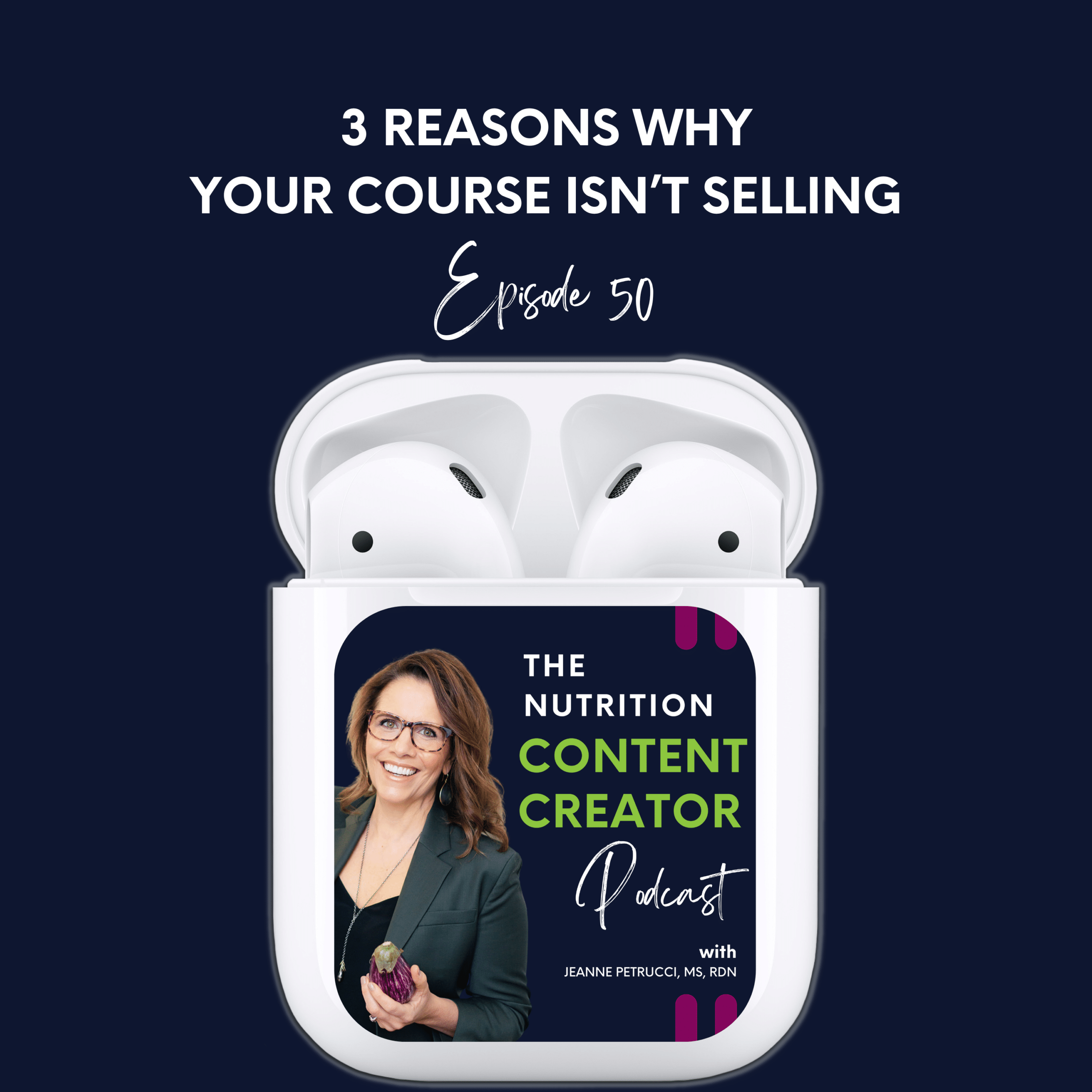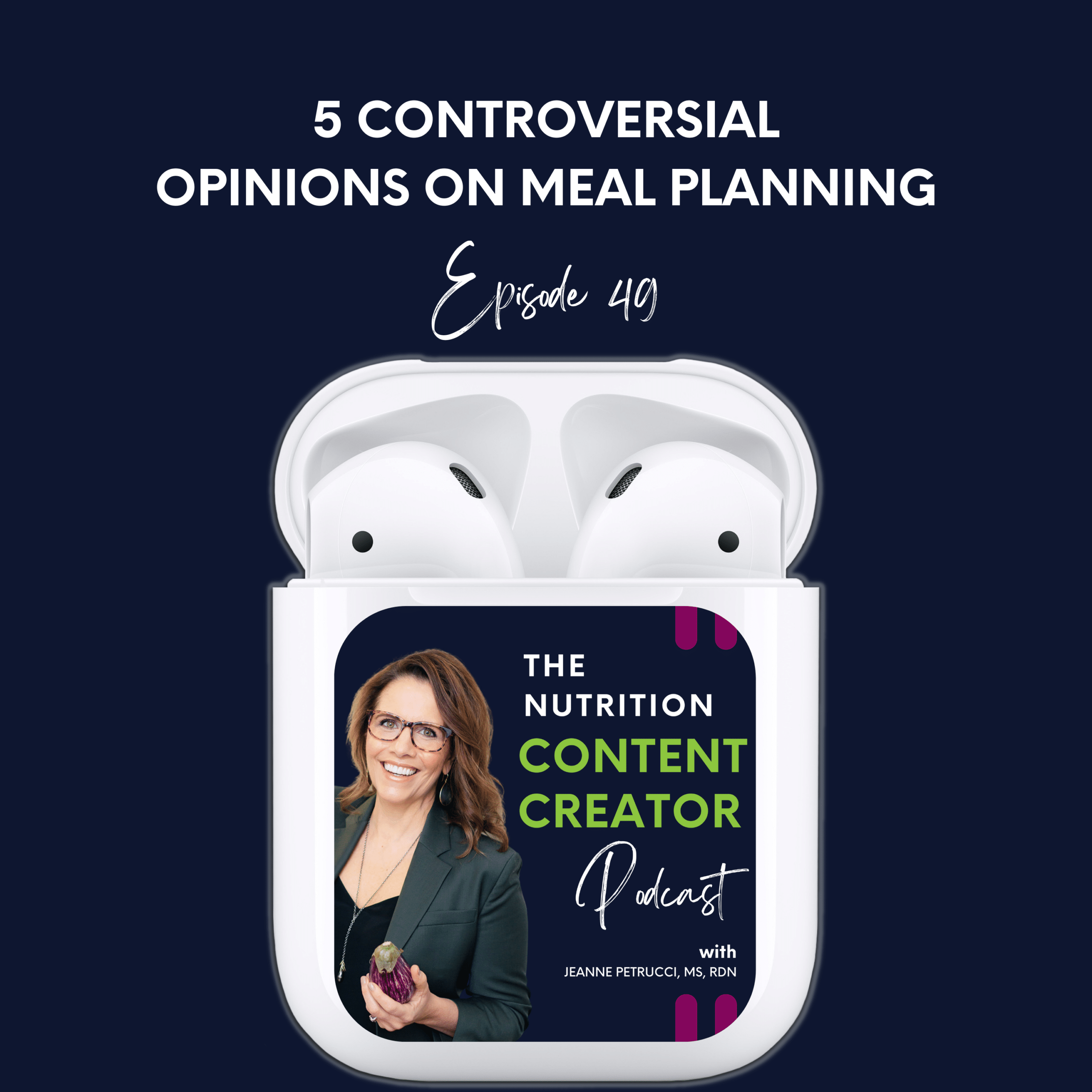50. 3 Reasons Why Your Course Isn’t Selling

COVID left its impact on private practice health and wellness professionals thrusting us all into the digital space whether we wanted it or not. Some of us embraced it and some went kicking and screaming but here we are, 4 years later, and it appears that virtual services are here to stay.
Digital courses exploded during this time and while I think they are still relevant, they appear to be losing some of their appeal. Mostly because of the market saturation.
It doesn’t mean we should move on to the next “thing” – whatever that is – but it does mean that we have to step up our game if we are to compete. It is essential that we not only stand out but also avoid the common pitfalls that many new course creators fall into.
Today we will talk about several predictable yet avoidable mistakes that could tank your digital course and what you can do to avoid them. I will introduce each problem by asking a question for you to consider.
We’ll cover:
- The ideal customer avatar
- Solutions for inadequate lead generation
- Eight questions to determine if your practice is ready for a digital course
Who are you serving?
Think about this: creating a course called ‘Healthy Eating Made Simple’ sounds great, but who is it for? If you can’t answer that clearly and concisely, you might end up spending a lot of energy speaking into a void. The broader your audience, the less specific your marketing message becomes, and unfortunately, the less effective it is.
So, what happens when your target audience is more of a guess than a precise decision? You end up creating generic content and messaging. Generic content tends to attract generic interest, which rarely translates into sales.
The Problem: Undefined ideal customer avatar
Without a clear target, your course is like a ship without a rudder—drifting in the ocean of thousands of other courses. It becomes difficult to create compelling marketing materials, set the right price, or even choose the best channels for promotion.
The Solution:
Nail down who you are talking to. If you have not yet listened to Episode #1, Are You Feeding a Starving Audience? it’s episode #1 for a reason – because every piece of content you create, including your digital course, starts with not only building the right customer persona but giving them everything they need to get the high-value outcome they desire.
Application to Course Creation:
Every aspect, from the content you include, and the assignments you set, to the marketing channels you choose, should speak directly to your persona’s needs and lifestyle.
How is the health of your funnel?
If your answer is, “What is a funnel?” you’ve identified the problem.
As someone in private practice, you are someone in business – and to have a sustainable business, you need a healthy sales funnel. One that not only attracts plenty of your ideal clients but one that nurtures them to paying clients and keeps them coming back for more.
Your funnel is your crucial pipeline of potential customers.
The Problem: Inadequate Lead Generation:
Without enough potential customers at the top of your funnel, it’s tough to maintain sales momentum. Why? Because not everyone who hears about your course will sign up. It’s a numbers game and here are the numbers.
What percentage of people in your funnel are you hoping will purchase your course? 30%? 20%? 10%? Nope. According to industry standards, 5% is an excellent result and that’s assuming your pool of prospects is full of your ideal customer avatar.
The Solution:
Get your funnel flowing. Figure out the technology you need to push people through your customer journey then start thinking about attraction strategies to get them in your funnel.
Here are four funnel solutions that can support the health of your funnel. These are not short-term solutions – getting a funnel flowing takes time, consistency, and patience so trust the process.
Content Marketing:
- Start by sharing valuable content that resonates with your defined audience. Whether it’s blog posts, free guides, or video tutorials, ensure each piece is crafted to address their specific needs and pique their interest in your course.
Social Media and Online Presence:
- We’ve talked quite a bit on the podcast about the necessity of showing up on social media – is it necessary? It depends – if you have other sources for attracting your ICA to your funnel then you may not need to spend a lot of time here. But when you do, make it count. You may not be able to sell your course directly using social media, but it can be a powerful tool to increase awareness of your offer.
- Use platforms where your target audience hangs out. Post engaging, interactive content that encourages followers to learn more about you, how you are different from the competition, and what transformation you can offer them
Host an event:
- You can increase the 5% conversion rate if you host an event or free workshop as a sales pipeline. This fills your funnel with not only your ICA but also those who have already decided to engage with you on a deeper level. If you add this type of lead magnet be sure to tag these people as they should be your priority when offering a course.
Paid Advertising:
- Paid ads can be a powerful tool for lead generation. This is the one solution that can accelerate the flow of your funnel. Use Facebook’s detailed targeting options, for instance, to reach prospective students by interests, demographics, and even behaviors.
- Workshops and webinars are ideal for Facebook ads and can be powerful drivers of email list growth.
- I recommend getting support with placing ads as they can get expensive if not set up properly and they do represent additional work. You’ll be generating creatives, captions, and landing pages to support them. Also, ads for health-related topics can be tricky to navigate as it is easy to violate Facebook’s policy. Engaging someone who has experience with this can save you time and potentially avoid your ad account being suspended.
What is the perceived value of your course?
We’re not talking dollars and cents here – we’re talking about return on investment. Your potential clients will weigh if their time and money are well spent here.
The Problem: Lack of perceived value
Lack of perceived value is usually related to the messaging around a course, not the course itself. Potential clients won’t be sold on all the bells and whistles that your course contains. They will be sold when you hit an emotional cord communicating specifically how you will solve their problem and help them achieve a transformation with this experience
The benefits or return on investment must be clear or they won’t bother signing up.
The Solution:
There are several solutions to improving the perceived value of your course.
Focus on Outcomes, Not Features:
Emphasize the transformation or outcomes that your course promises. For example, rather than merely listing “10 modules on nutrition basics,” highlight what the learner will achieve, like “better management of blood sugar levels to reduce risk of developing diabetes.” That would be a high-value outcome for clients who are pre-diabetic and don’t want to go on medications.
Use clear, relatable examples to illustrate these outcomes. For instance, describe a before-and-after scenario for a typical student, such as someone who reversed their prediabetes and now has a lower risk of developing a chronic disease and improved longevity.
Showcase Tangible Benefits:
Be specific about the benefits. Vague promises like “improve your health” are less compelling than “reduce your blood sugar levels within three weeks.”
Include statistics or research findings that support the effectiveness of your approach, if available. Citing specific studies or experts can increase credibility and show the science behind your methods.
Incorporate Social Proof:
Share testimonials from past clients who have seen significant benefits from working with you. Real-world examples of success stories are powerful motivators as your potential clients will see themselves in these testimonials.
If you have offered a beta program, which I strongly recommend, you can offer a detailed case study that walks potential students through the course journey and its impact. This can illustrate the practical application and benefits of your course.
Listen to Episode #16 for more details on running a beta offering of your course.
Reduce Risk with Guarantees:
This tends to make most of us uncomfortable because it seems risky. The only way you can get over this uncomfortable feeling is to feel so confident that your course will deliver, it’s a no-brainer. Listen to Episode #34 where I discussed what it takes to create an irresistible offer.
Offer a money-back guarantee if a student does the work and feels the course did not deliver the promised outcomes. This can alleviate fears of financial loss and demonstrate confidence in your course’s value.
You can also consider offering a free trial period or a preview module. This allows potential students to experience the course’s value firsthand before committing to the full price.
If you put this solution in action and receive a high volume of refund requests or if people don’t opt in, then you need to take a close look at the actual value your course is providing and rework it.
Is your practice ready for a course?
The answers to these first three questions relate to what we have already talked about:
Have you identified who your course is for?
Ensure you have a well-defined target audience whose needs and challenges are well understood by your practice. This ensures that your course content is highly relevant and targeted.
Do you have a strategy to attract and convert leads in your funnel?
A solid marketing plan should be in place to ensure that you can generate interest and convert it into sales. This includes having active lead generation channels, effective use of social media, and possibly paid advertising strategies.
Does your course offer clear and compelling value to potential customers?
Your course should solve specific problems or fulfill the needs of your target audience in a way that they see as a worthwhile investment. This could be through unique content, proven results, or through additional support like live Q&A sessions or community access.
Here are some other considerations:
Do you have the resources and technology to support a quality learning experience?
Ensure you have the right tools and technology to deliver your course content smoothly. This includes a reliable course platform, customer support, and possibly, tools for interactive elements and student engagement.
Is your course content well-organized and of high quality?
The course should be structured in a way that progressively builds knowledge and skills, is easy to follow, and is engaging. High-quality, actionable content is key to keeping students motivated and committed.
Are you ready to keep the course updated and respond to feedback?
A course is not a “set it and forget it” product. Be prepared to update content, incorporate student feedback, and continuously improve the course to maintain its relevance and effectiveness.
Can your practice absorb the initial costs associated with creating and marketing the course?
Developing a course requires an upfront investment in time and money. Make sure your practice’s finances can support this endeavor without jeopardizing other areas of your business.
Is there still a demand for your course topic in the market?
Research current trends in nutrition education to ensure your course topic is in demand. Offering something that aligns with ongoing or emerging trends can increase its success rate.
You’ll also want to ensure that your course offers something unique in the market – listen the Episode #4 where we talk about creating a Blue Ocean practice. The principles discussed can be applied to creating a Blue Ocean product as well.
Your Content Cure for This Week
For this episode, we’ve put together a guide and checklist that provide a structured approach to creating a digital course, ensuring that all major aspects are covered to maximize the course’s potential success. The checklist format makes it easy for you to follow and implement the steps necessary to avoid common pitfalls and effectively market your courses.
>> DOWNLOAD YOUR RESOURCES HERE<<
Key Takeaway
In a digital age saturated with courses, ensuring sales requires pinpointing your audience, nurturing a healthy sales funnel, and emphasizing tangible value. Clarity on who you serve, effective lead generation, and highlighting outcomes over features are crucial. Additionally, readiness in terms of resources, market demand, and ongoing updates is vital for success.

Jeanne Petrucci MS RDN
Founder, Expert Nutrition Content Creator


